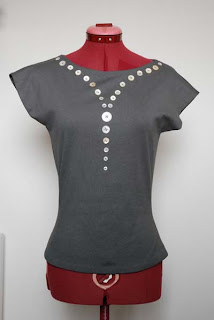You can basically use any kind of knit fabric for this pattern although I wouldn't recommend really flimsy, very stretchy kinds of jersey. Because this pattern actually has ease, you can use those odd knits which hardly stretch at all (you can sometimes find those on the bargain table of your fabric store...). When I use a fabric like that, I cut the top a bit wider by adding 1 cm between the fold of the fabric and center back/front.
When cutting, center back and center front should obviously be placed on the fold. The straight grain line on the sleeve is that vertical help line you drew. And I don't think I have to tell anyone that you can fold your fabric differently than just in half if that makes cutting more economical... Just make sure the folds are straight, preserving the straight grain (which is not really the right term in a knit, but you know what I mean.
Now, the sewing starts. I usually use the serger straight away on a knit fabric but you could also use a stretch stitch on your sewing machine.
The first thing to sew is that neckline.
I've made this top with and without fusible interfacing in the neckline and my choice in the matter depends on the fabric. If it is likely to roll, interface. If not, you can do without. The interfacing gives the neckline a more defined edge, without is a bit softer. Both work well.
If you use interfacing, use quite a thin variety which is suitable for knits (this will still reduce the stretch by quite a bit so if you want to use it, make sure your neckline is big enough to let your head pass through without relying on stretch).
Finish the edges of the neckline facings.
Press the facings to the wrong sides of the bodice pieces.
Pin the shoulder lines, with the front facing in place.
Fold the back facing over the front facing and pin through all layers. Make sure to remove any pins under the facing.
Sew the shoulder seams, including those facings.
Turn right side out and press on the inside. Now you have shoulder seams and a neatly finished neckline.
Insert sleeves. Pay attention when pinning, there is a difference between front and back of the sleeve.
Sew side seams and arm seams in one go.
Hem bottom edge en sleeves.
Finished!


















































